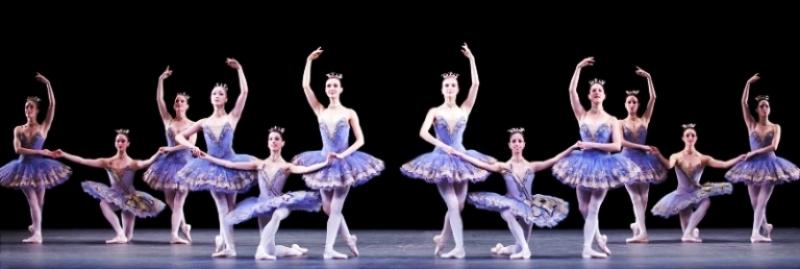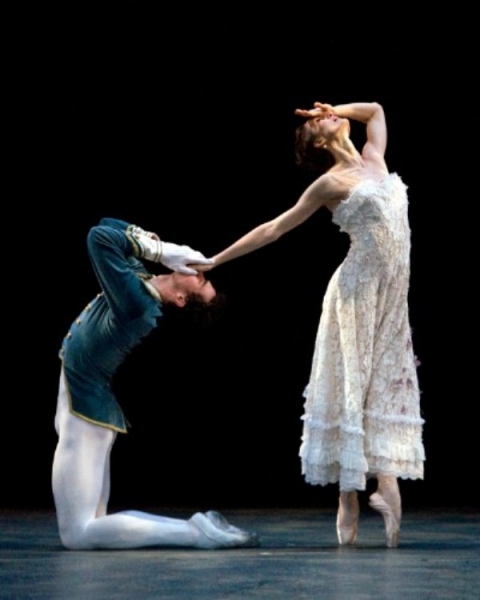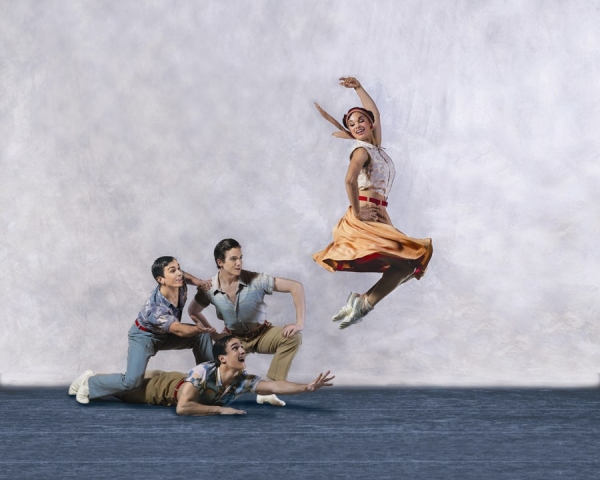American Ballet Theatre, Prog 2, Sadler’s Wells | reviews, news & interviews
American Ballet Theatre, Prog 2, Sadler’s Wells
American Ballet Theatre, Prog 2, Sadler’s Wells
What a difference a change of programme makes

Jardin aux Lilas is one of ABT’s great calling cards, and it was danced with great seriousness of purpose and devotion by an admirably schooled cast.
 Jardin is Janus-faced: it is at one and the same time terribly moving and a work of complete hokum. The choreography is restrained, verging on inhibited: low lifts, small steps, all movement above the knee frozen, except for the unexpected deep backbends, which therefore become startling. The set, by Peter Cazalet, is delicately restrained in an indigo range of tones. (The lighting, uncredited, is also potent.) Yet the scenario could come from any barnstorming melodrama of the previous century.
Jardin is Janus-faced: it is at one and the same time terribly moving and a work of complete hokum. The choreography is restrained, verging on inhibited: low lifts, small steps, all movement above the knee frozen, except for the unexpected deep backbends, which therefore become startling. The set, by Peter Cazalet, is delicately restrained in an indigo range of tones. (The lighting, uncredited, is also potent.) Yet the scenario could come from any barnstorming melodrama of the previous century.
The characters both embody Tudor’s desire for psychological truth, and are cartoonishly delineated: the discarded mistress is clearly going to come to a bad end, as she wears a purple feather in her hair; the fiancé – in stock melodrama style, credited as The Man She Must Marry – is just as obviously incapable of understanding his beautiful Caroline because he is wearing a frock coat when all the other men are in dashing Ruritanian uniforms. And so on. Yet the magic works, the spell is not broken, and when the curtain falls, the audience barely breathes.
Theme and Variations (main picture, above) suffered from an underpowered principal pairing: Gillian Murphy and David Hallberg both underwhelmed. Neither appears to have any ability to listen to the music, which is playing, after all, for a reason, and thus they have no ability to be moved (literally and figuratively) by it. Both, too, are a little stolid, a little slow, and Murphy in particular blurs her steps when she moves at speed.
Xiomara Reyes showed similar problems in the show-stopper that is the Tchaikovsky Pas de Deux: unmusical (almost anti-musical), she fails to shape a phrase, and so, as Balanchine and Tchaikovsky ratchet up the tempo, she is left gallantly coming up from behind, not really the position you want to be in. She also has the great (mis-)fortune to be dancing with Herman Cornejo, a dazzling technician, and a fine musical presence to boot (not a pairing one sees very often): fortune because she was carried along in his wake; misfortune because she could only look lesser. Cornejo is an astonishing virtuoso, performing leaps of great height and complexity, and yet maintaining a crystalline clarity. But that’s not what makes him a great dancer. What makes him a great dancer is his legato, singing line, his ability to take a step, then a series of steps, and bend and shape them to the tempo of the music, to create a breathless space where movement and sound are fused.
 And that, too, is what Paul Taylor has done in his 1991 piece, Company B (pictured left), which ABT has been performing for a couple of years now. It suits them wonderfully well, and they triumph in it. On paper, a piece to the World War Two songs of the Andrews Sisters is a feel-good, leave-’em-stamping-in-the-aisles finale. But Taylor, that great contrarian, is not willing to do something that obvious. Instead, a series of nine peppy songs brings us all the fun and can-do-ness of the Forties. They also, without remotely hammering home the point, tells us that these cheerful children are going off to die.
And that, too, is what Paul Taylor has done in his 1991 piece, Company B (pictured left), which ABT has been performing for a couple of years now. It suits them wonderfully well, and they triumph in it. On paper, a piece to the World War Two songs of the Andrews Sisters is a feel-good, leave-’em-stamping-in-the-aisles finale. But Taylor, that great contrarian, is not willing to do something that obvious. Instead, a series of nine peppy songs brings us all the fun and can-do-ness of the Forties. They also, without remotely hammering home the point, tells us that these cheerful children are going off to die.
Nothing is straightforward in this piece. It opens with the dancers in shadow, a white space with black shapes moving gently across, hips swinging slightly to the rhythm, but nothing more. Then the lights come up, and in Santo Loquasto’s autumn-khaki palette, the company takes off. Roddy Doble and Marian Butler do a vivid “Pennsylvania Polka”; Craig Salstein is a cheerily horn-rimmed Clark Kent-ish oddball (but he gets all the girls) in “Oh Johnny, Oh Johnny, Oh!” Yet in “I Can Dream, Can’t I?” Nicola Curry dances alone, imagining she is with her man; while behind, in shadow, “her” man is dancing with another man. Throughout, when least expected, men fall, as if shot – and you realise, they have been shot. No one leaves the stage together; the girls are left alone, the men left to something most likely worse. They – we – are all ghosts of a good time.
- American Ballet Theatre shows Programme 2 ( as above) Saturday, Sunday; Programme 1 (Ratmansky, Tharp, Balanchine, Millepied) Thursday, Friday
- See what's on at Sadler's Wells. Read Sadler's Wells show reviews
- Find ABT DVDs on Amazon
Explore topics
Share this article
The future of Arts Journalism
You can stop theartsdesk.com closing!
We urgently need financing to survive. Our fundraising drive has thus far raised £49,000 but we need to reach £100,000 or we will be forced to close. Please contribute here: https://gofund.me/c3f6033d
And if you can forward this information to anyone who might assist, we’d be grateful.

Subscribe to theartsdesk.com
Thank you for continuing to read our work on theartsdesk.com. For unlimited access to every article in its entirety, including our archive of more than 15,000 pieces, we're asking for £5 per month or £40 per year. We feel it's a very good deal, and hope you do too.
To take a subscription now simply click here.
And if you're looking for that extra gift for a friend or family member, why not treat them to a theartsdesk.com gift subscription?
more Dance
 'We are bowled over!' Thank you for your messages of love and support
Much-appreciated words of commendation from readers and the cultural community
'We are bowled over!' Thank you for your messages of love and support
Much-appreciated words of commendation from readers and the cultural community
 Like Water for Chocolate, Royal Ballet review - splendid dancing and sets, but there's too much plot
Christopher Wheeldon's version looks great but is too muddling to connect with fully
Like Water for Chocolate, Royal Ballet review - splendid dancing and sets, but there's too much plot
Christopher Wheeldon's version looks great but is too muddling to connect with fully
 iD-Reloaded, Cirque Éloize, Marlowe Theatre, Canterbury review - attitude, energy and invention
A riotous blend of urban dance music, hip hop and contemporary circus
iD-Reloaded, Cirque Éloize, Marlowe Theatre, Canterbury review - attitude, energy and invention
A riotous blend of urban dance music, hip hop and contemporary circus
 How to be a Dancer in 72,000 Easy Lessons, Teaċ Daṁsa review - a riveting account of a life in dance
Michael Keegan-Dolan's unique hybrid of physical theatre and comic monologue
How to be a Dancer in 72,000 Easy Lessons, Teaċ Daṁsa review - a riveting account of a life in dance
Michael Keegan-Dolan's unique hybrid of physical theatre and comic monologue
 A Single Man, Linbury Theatre review - an anatomy of melancholy, with breaks in the clouds
Ed Watson and Jonathan Goddard are extraordinary in Jonathan Watkins' dance theatre adaptation of Isherwood's novel
A Single Man, Linbury Theatre review - an anatomy of melancholy, with breaks in the clouds
Ed Watson and Jonathan Goddard are extraordinary in Jonathan Watkins' dance theatre adaptation of Isherwood's novel
 Peaky Blinders: The Redemption of Thomas Shelby, Rambert, Sadler's Wells review - exciting dancing, if you can see it
Six TV series reduced to 100 minutes' dance time doesn't quite compute
Peaky Blinders: The Redemption of Thomas Shelby, Rambert, Sadler's Wells review - exciting dancing, if you can see it
Six TV series reduced to 100 minutes' dance time doesn't quite compute
 Giselle, National Ballet of Japan review - return of a classic, refreshed and impeccably danced
First visit by Miyako Yoshida's company leaves you wanting more
Giselle, National Ballet of Japan review - return of a classic, refreshed and impeccably danced
First visit by Miyako Yoshida's company leaves you wanting more
 Quadrophenia, Sadler's Wells review - missed opportunity to give new stage life to a Who classic
The brilliant cast need a tighter score and a stronger narrative
Quadrophenia, Sadler's Wells review - missed opportunity to give new stage life to a Who classic
The brilliant cast need a tighter score and a stronger narrative
 The Midnight Bell, Sadler's Wells review - a first reprise for one of Matthew Bourne's most compelling shows to date
The after-hours lives of the sad and lonely are drawn with compassion, originality and skill
The Midnight Bell, Sadler's Wells review - a first reprise for one of Matthew Bourne's most compelling shows to date
The after-hours lives of the sad and lonely are drawn with compassion, originality and skill
 Ballet to Broadway: Wheeldon Works, Royal Ballet review - the impressive range and reach of Christopher Wheeldon's craft
The title says it: as dancemaker, as creative magnet, the man clearly works his socks off
Ballet to Broadway: Wheeldon Works, Royal Ballet review - the impressive range and reach of Christopher Wheeldon's craft
The title says it: as dancemaker, as creative magnet, the man clearly works his socks off
 The Forsythe Programme, English National Ballet review - brains, beauty and bravura
Once again the veteran choreographer and maverick William Forsythe raises ENB's game
The Forsythe Programme, English National Ballet review - brains, beauty and bravura
Once again the veteran choreographer and maverick William Forsythe raises ENB's game
 Sad Book, Hackney Empire review - What we feel, what we show, and the many ways we deal with sadness
A book about navigating grief feeds into unusual and compelling dance theatre
Sad Book, Hackney Empire review - What we feel, what we show, and the many ways we deal with sadness
A book about navigating grief feeds into unusual and compelling dance theatre

Add comment